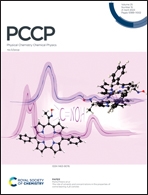Tuning the odd–even effect on two-dimensional assemblies of curcumin derivatives by alkyl chain substitution: a scanning tunnelling microscopy study†
Abstract
Well-ordered molecular arrangement on surfaces is fundamental for fabrication of functional molecular devices which are of particular interest in nanotechnology. In addition to nano-manufacturing, the production of useful materials from natural resources has recently attracted increasing attention. Herein, we focused on the two-dimensional (2D) self-assemblies of curcumin derivatives. The effects of the number, length, and substitution of the alkyl chains on the 2D structures of curcumin derivatives were studied by scanning tunnelling microscopy at the highly oriented pyrolytic graphite/1,2,4-trichlorobenzene interface. Curcumin derivatives containing both methoxy and alkoxy chain groups and those possessing four alkoxy chains exhibit linear structures with and without interdigitation of alkoxy chains, respectively. These 2D structure formations are independent of the alkyl chain length. However, the bisdemethoxycurcumin derivatives periodically form stair-like and linear structures depending on the alkyl chain length, which indicates the existence of the odd–even effect. These results suggest that the 2D structural modulation of curcumin derivatives caused by the odd–even effect can be tuned by the number of alkyl chain substituents. The appearance and disappearance of the odd–even effect in curcumin derivatives are discussed in terms of the balance between intermolecular and molecule–substrate interactions.



 Please wait while we load your content...
Please wait while we load your content...